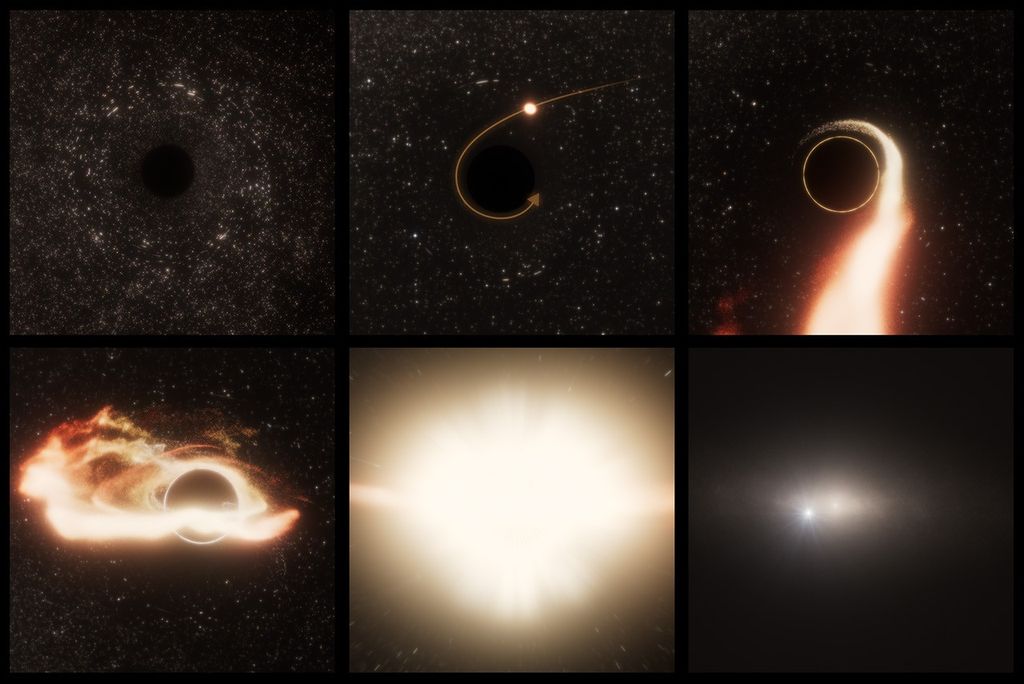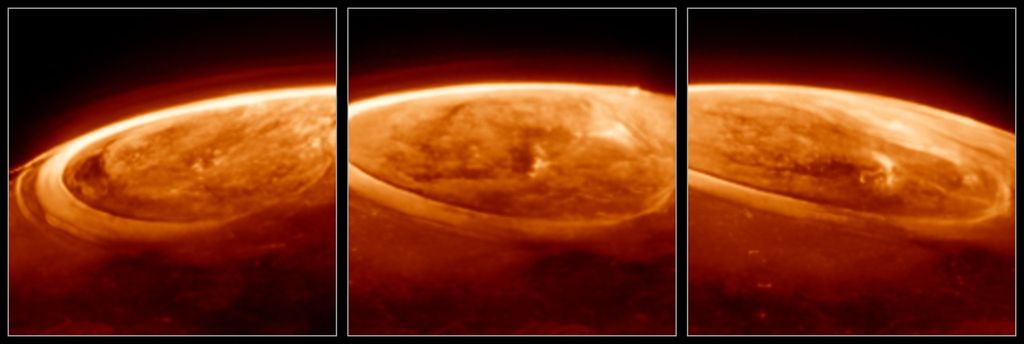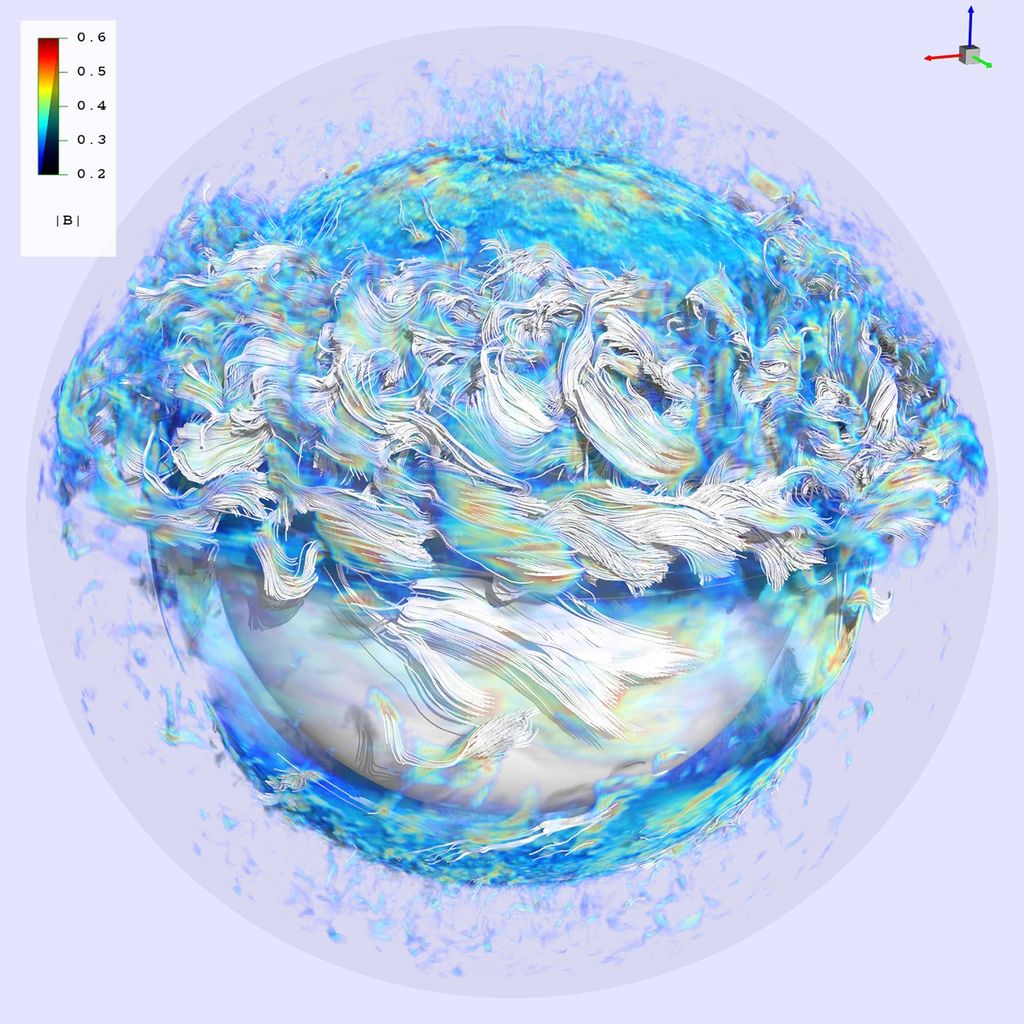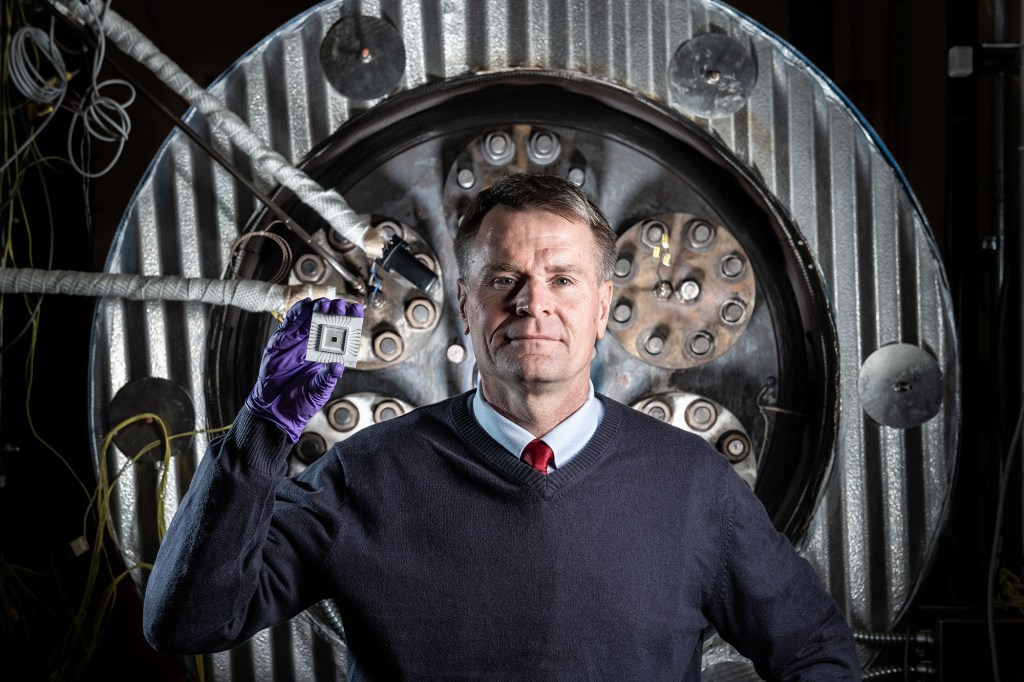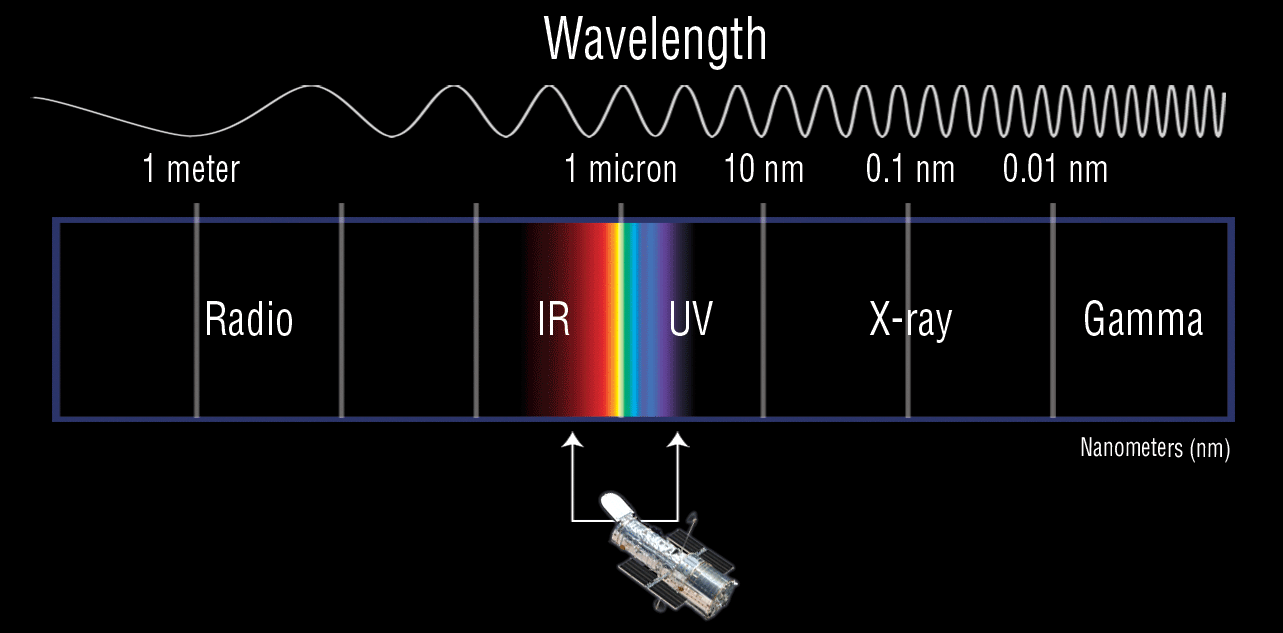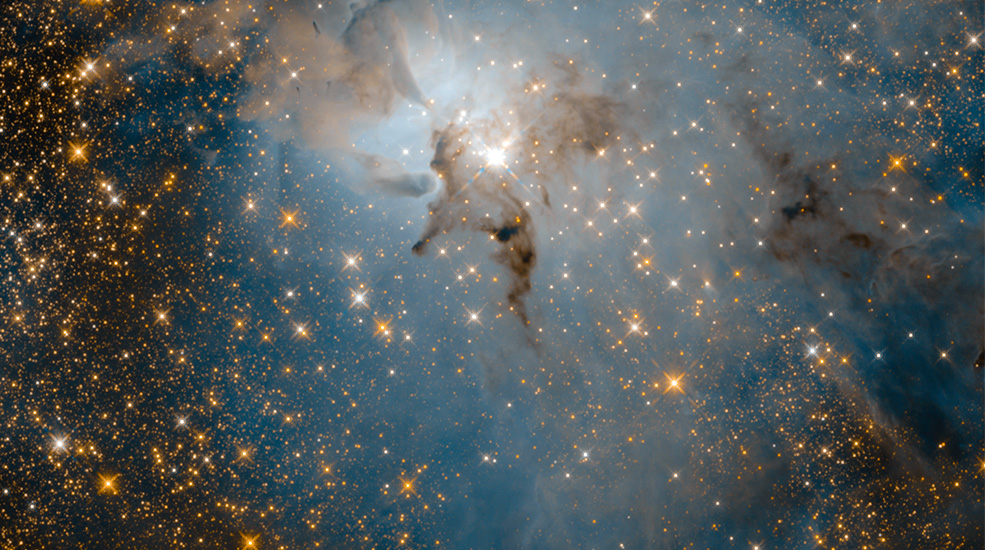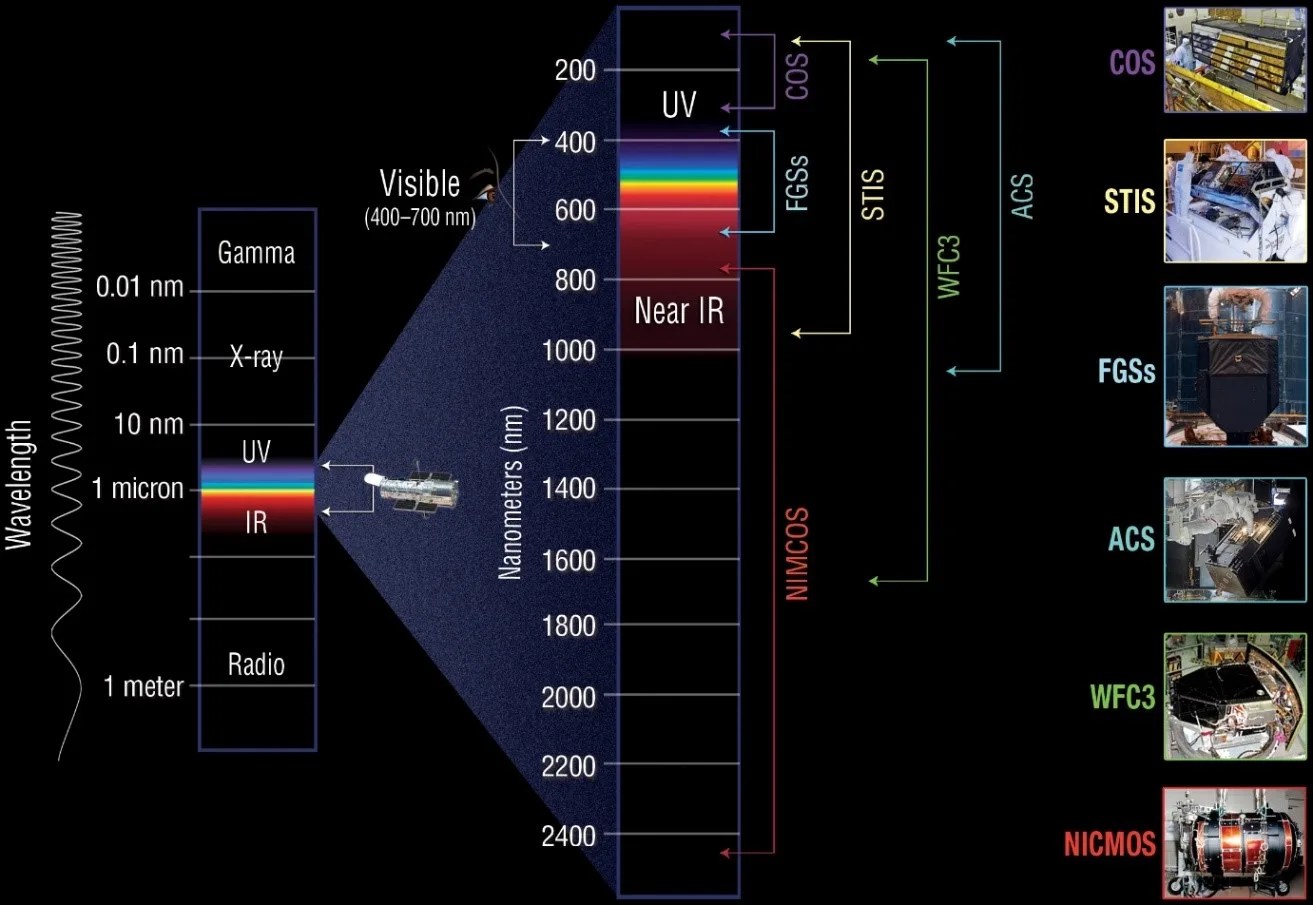Science
In a Different Light
Astronomers use light and the different wavelengths or colors at which it radiates to uncover the mysteries of the universe. Each point, or pixel, in an astronomical image may represent temperature, a wavelength of light, or the intensity of the signal. Each color brings into view an otherwise invisible universe.


VISIBLE & INFRARED
Mystic Mountain
Revealing the Difference Between Visible and Infrared Light: These images of Mystic Mountain – a pillar of gas, dust, and newborn stars in the Carina Nebula – show how observations taken in visible and infrared light reveal different details of an object.
Visible Light
Human eyes can see only a small portion of the range of radiation given off by the objects around us. We call this wide array of radiation the electromagnetic spectrum, and the part we can see “visible light.”
By only seeing visible light, we miss out on the information conveyed by other types of radiation. Other Earth creatures can see some of the spectrum we are blind to. Certain fish, bullfrogs and snakes, for instance, can see infrared radiation, which helps them find prey through murky water or in the dark. Butterflies and some species of birds can see ultraviolet light, which helps them identify certain markings on mates.
When it comes to cosmic objects, key information is revealed by different portions of the electromagnetic spectrum. Telescopes are designed to capture different portions of this spectrum, providing more information than the human eye could detect on its own. The Hubble Space Telescope can detect a portion of infrared and ultraviolet wavelengths as well as visible light.

Because our atmosphere blocks or partially absorbs certain wavelengths, Hubble’s position 320 miles above Earth’s surface puts it in a location where it can capture details of objects that would be difficult or impossible for ground-based telescopes to observe.
Hubble has also worked in concert with other telescopes, combining its observations with those of wavelengths observed by other space telescopes. In these cases, the combined or contrasting images provide more information about the object than either image could alone.
Infrared Light
The short wavelengths of visible light make them prone to bumping into particles in their path, scattering the light and blocking it from progressing. Infrared-light wavelengths are longer and more likely to slip between particles. In space, this allows infrared wavelengths to penetrate all but the densest regions of dust. By viewing infrared light, we can essentially look through cosmic clouds of gas and dust to the objects behind and within them. Infrared light is also emitted by warm material too dim to glow significantly in visible light, and can allow us to see those objects.
Seeing infrared light is the only way to view many cosmic objects. As the light from the universe’s most distant galaxies travels through space, it’s stretched by the expansion of space. By the time the light reaches Earth, that stretching process has transformed short wavelengths of visible and ultraviolet light into the longer wavelengths of infrared light. Only telescopes that can detect infrared light can see those faraway galaxies.

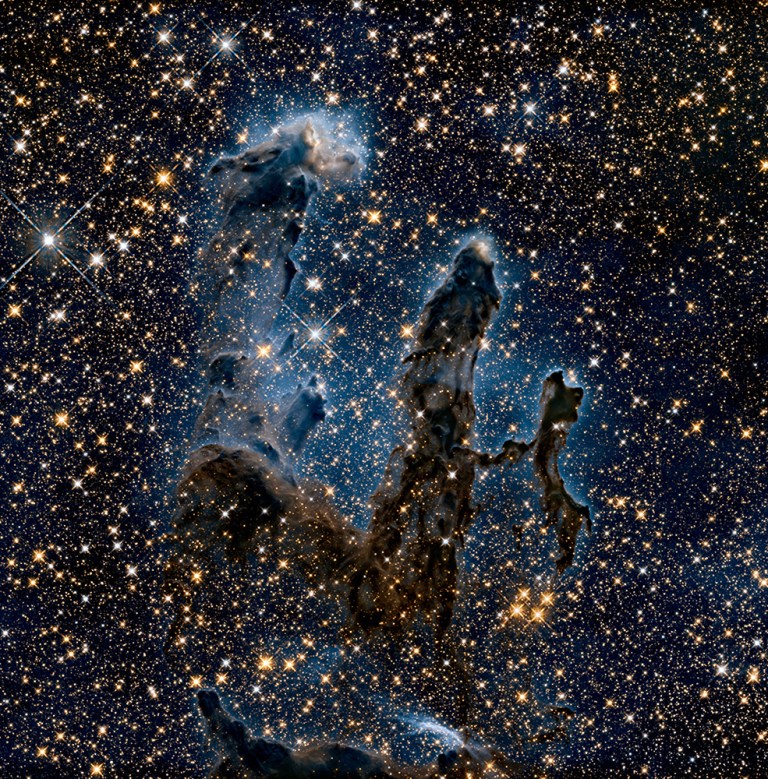
Visible & infrared
Eagle Nebula
Many will recognize this popular image of a portion of the Eagle Nebula, but there's also a lesser-known second image that reveals more about this cosmic landscape. Move the slider from left to right to reveal the image in visible and infrared light.
Many will recognize this popular image of a portion of the Eagle Nebula, but there's also a lesser-known second image that reveals more about this cosmic landscape. The famous visible-light image shows 5-light-year-tall pillars of cold hydrogen gas laced with dust, where stars are being born. Radiation from nearby stars, located off the top of the image, illuminate the pillars and heat the gas, which evaporates into space as streamers from the tips of the pillars. In the second Hubble image, infrared light flows through the clouds, revealing a vast number of the stars both past the nebula and blazing to life within it. Note the bright, newborn stars now obvious in the tops of the pillars in the infrared image.


Visible & infrared
Lagoon Nebula
Hubble's visible-light image (left) of the Lagoon nebula reveals colorful swirls and dark pillars of gas and dust. The telescope's near-infrared image unveils stars within the cloud as well thousands of background stars.
In the visible-light image, the Lagoon Nebula is a nearly impenetrable cloud of gas and dust. Buried in its center is a hint of a monster-sized young star 200,000 times brighter than the Sun whose radiation is carving and shaping the nebula around it. Infrared light penetrates the nebula to unveil that blazing star, known as Herschel 36, as well as the myriad of background stars behind the nebula and many that were cloaked in its dust.


Visible & infrared
Carina Nebula Pillar
Hubble's visible-light image (left) of the Carina Nebula holds small bright dots that hint at the stars forming within. The telescope's near-infrared image (right) reveals these stars in all of their brilliant glory.
This pillar in the Carina Nebula hides newborn stars in its depths, cloaked in layers of gas and dust. In the visible-light image, we get a hint of what’s inside. Thin puffs of material and wispy clouds appear to sprout from a dark notch in the pillar’s center – a jet of matter being flung into space by a newborn star. The infrared image reveals both the star and its 10-light-year-long jet, which is pouring into space at around 850,000 miles per hour.
GOODS North
NASA, ESA and G. Bacon (STScI)
The GOODS North image includes one of the earliest objects ever observed – GN-z11, seen as it was 13.4 billion years in the past. The distant galaxy’s light arrives in our corner of the universe after having been stretched by its trip across the expanding universe into infrared wavelengths. Because this light has been traveling for so long, it shows us the galaxy as it was just 400 million years after the Big Bang. This video zooms into the GOODS North image starting with its location in the sky and ending with our infrared glimpse of GN-z11.
Ultraviolet Light
High-energy ultraviolet radiation is mostly blocked by Earth’s atmosphere – and that’s good for us, since we can’t survive too much of it. But because we can’t see it, we’re missing out on some spectacular cosmic phenomena, including light from the hottest and youngest stars embedded in local galaxies, and auroras that glow on the outer planets of our solar system. Ultraviolet observations can also help us determine the composition of the atmospheres of planets beyond our solar system. Only the Hubble Space Telescope is currently capable of making high-resolution ultraviolet light observations.


Ultraviolet Light
Saturn
Hubble's visible-light image (left) of Saturn reveals the planets rings and atmospheric cloud bands. The telescope's ultraviolet view (right) pulls out more detail in the planets ring system, while showcasing a bright atmospheric cloud band (seen in yellow) near the planet's equator.
The bands circling Saturn in these images are actually haze and cloud layers, composed of different particles of gas. Here both the visible and ultraviolet images of Saturn are portrayed in false colors to make differences stand out. Some particles reflect ultraviolet light more than visible light, causing parts of Saturn to appear brighter in the ultraviolet than the visible. These images show how certain gases are more prominent in the lower atmosphere than the upper, and vice versa. Only by combining and comparing these different images, in a set such as this one, can researchers interpret the data and better understand the planet.
Auroras
NASA, ESA and J. Nichols (University of Leicester)
Auroras are caused by high-energy particles that travel along a planet's magnetic poles, where they excite atmospheric gases and cause them to glow. On Earth, the particles collide with oxygen and nitrogen gases to give off visible light in multiple shimmering colors. On the outer planets, they interact with hydrogen-heavy atmospheres, causing an ultraviolet light show visible to Hubble – as in this time-lapse series of images of ultraviolet auroras shimmering at Jupiter's north pole.
Comet Impacts on Jupiter
In 1994, the pieces of the shattered comet Shoemaker-Levy 9 plunged into Jupiter while Hubble watched. In images taken in visible light (left), the impact areas appear as relatively faint smudges scattered over the southern hemisphere of the gas planet. The ultraviolet image of Jupiter (right), however, shows the large quantities of UV-absorbing dust spreading high in the atmosphere following the impacts. Because the fine particles are easier to see in ultraviolet light, this image gives us a clearer picture of the comet residue and materials thrown from Jupiter’s lower atmosphere into the upper atmosphere by the impact. The dark dot near the top of the ultraviolet image is Jupiter's moon Io.
Hubble Ultra Deep Field (2014)
Astronomers captured ultraviolet light with Hubble to provide this more-comprehensive 2014 version of its Hubble Ultra Deep Field image, which had previously consisted of visible- and infrared-light observations taken between 2003–2009. This image contains all three wavelengths: visible, infrared and ultraviolet.
Ultraviolet light comes from the hottest, largest and youngest stars. By observing ultraviolet light, scientists can see which galaxies are forming stars and where the stars are forming within those galaxies.
Ultraviolet and visible light from the farthest galaxies is stretched into infrared light as it travels across the expanding universe. But for a distance extending from about 5 billion to 10 billion light-years – showing galaxies from the period when most of the stars in the universe were born – ultraviolet-light observations are key.
Collaborations with Other Telescopes
Telescopes often specialize in specific wavelengths of light. The infrared-studying Spitzer Space Telescope, the Chandra X-ray Observatory spacecraft, and the National Radio Astronomy Observatory on Earth are examples of observatories with this targeted focus. Hubble has worked in concert with other telescopes to create images of cosmic objects that incorporate a wide range of wavelengths, each image a piece of a puzzle that eventually reveals a complete view of the object and conveys unique information about the processes taking place.
The Crab Nebula
NASA, ESA and J. DePasquale (STScI)
This composite image of the Crab Nebula – loops of gas and debris cast off by the explosive death of a star, energized by a compressed stellar core called a neutron star at its heart – was created by combining the data from five telescopes, spanning nearly the entirety of the electromagnetic spectrum. The red, radio-light view shows how the neutron star’s “wind” of charged particles energizes the nebula, causing it to emit radio waves. The yellow, infrared image highlights the glow of dust particles absorbing ultraviolet and visible light. The green Hubble image offers a visible-light view of hot filamentary structures throughout the nebula. The blue, ultraviolet image and purple, X-ray image show the effects of an energetic cloud of electrons driven by the rapidly rotating neutron star at the nebula’s center.


Visible & Radio
Hercules A
Hubble's visible-light image (left) of Hercules A is superimposed with the radio wavelength view (right) of the galaxy revealing powerful jets ejected by the supermassive black hole at the galaxy's core.
This visible-light image from Hubble shows a seemingly ordinary elliptical galaxy surrounded by other, smaller galaxies. But in that galaxy’s center lies a black hole as massive as 2.5 billion suns. The gravitational energy and fast rotation of the supermassive black hole is creating enormous jets, focused by magnetic fields, that are 1.5 million light-years long and far surpass the size of the galaxy they emanate from. The jets are made of high-energy plasma beams, subatomic particles and magnetic fields shot at nearly the speed of light from the vicinity of the black hole. Because they emit radio waves, they’re invisible to the human eye and Hubble, but fill the combined radio and visible-light image. Hercules A is one of the brightest extragalactic radio sources in the entire sky.


Visible & X-ray
Supernova Remnant 0509-67.5
Hubble's visible-light image (left) of the supernova remnant known as SNR 0509-67.5 is a delicate sphere of expanding gas and dust. The composite visible and X-ray image (right) reveals the X-ray glow of material heated by the blast wave.
This bubble is a supernova remnant – what’s left of a star that exploded nearly 400 years ago. As the blast from the explosion expands, the ejected material travels outward at more than 11 million miles (17.7 million km) per hour. In the visible-light image taken by Hubble, the glowing pink shell is created when the supernova blast wave compresses and expands the surrounding gas. In the combined visible-light and X-ray image, we also see the soft green and blue hues of material that has been heated to millions of degrees until it glows in X-rays.
Hubble's Instruments
Hubble Science Highlights
Learn about Hubble's scientific discoveries.

Monster Black Holes are Everywhere
Hubble found that supermassive black holes lie at the heart of nearly every galaxy.

Studying the Outer Planets and Moons
Hubble’s systematic observations chart the ever-changing environments of our solar system's giant planets and their moons. about the history of Glenn Research Center.

Exploring the Birth of Stars
Hubble’s near-infrared instruments see through the gas and dust clouds surrounding newborn stars.


